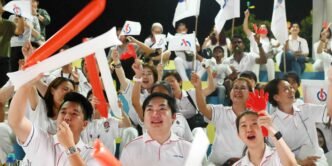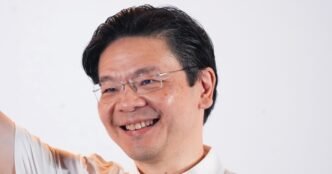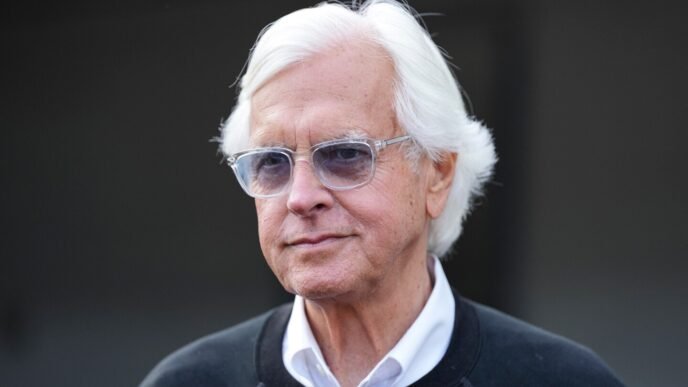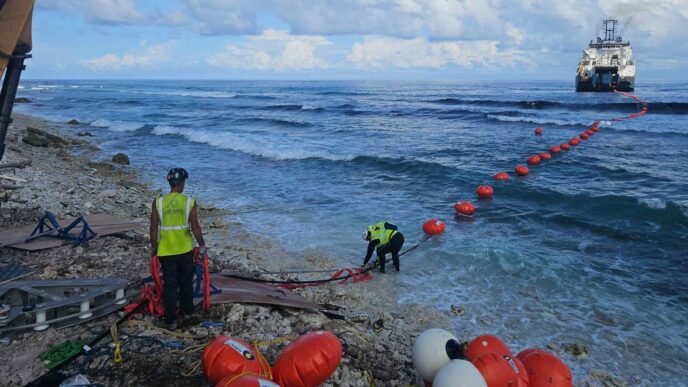SINGAPORE — Singaporeans cast their ballots Saturday to elect their representatives to the country’s unicameral parliament for the next five-year term.
Prime Minister Lawrence Wong’s ruling People’s Action Party, which has governed the country since its independence in 1965, retained its supermajority. You can read our news story on the PAP’s victory here.
Here’s how it happened (Singapore time):
3:55 a.m. That’s a wrap for the blog. Thanks for staying with us through the night. Nikkei Asia will continue to cover Singapore’s politics, including how the government will tackle ongoing challenges such as the global trade war and rising cost of living.
3:45 a.m. In a news conference after polling results were all announced, Wong says he is “humbled and grateful” for the support given to his party, pledging to work even harder for voters. “Singaporeans have given the PAP a clear and strong mandate to govern,” he says. “The results will put Singapore in a better position to face this turbulent world.”
1:55 a.m. The PAP’s overall vote share reaches 65.6%, improving from the 61.2% in the previous election in 2020. But it is below its 2015 showing of 69.9%.
1:50 a.m. All results are in. The PAP has secured 87 of the 97 parliament seats, while the remaining 10 seats go to the Workers’ Party. The main opposition group keeps the same number from the 2020 election.
1:40 a.m. Singapore’s biggest opposition group, the Workers’ Party, has equalled its record 10 parliament seats in the 2020 election. Its team in the Sengkang constituency won 56.31% of the votes, adding to its wins in the Aljunied and Hougang constituencies.
1:25 a.m. The PAP has reached 67 parliament seats versus the WP’s six, with votes in 24 constituencies still being counted. This gives it a supermajority in Singapore’s parliament, which enables it to push through bills easily without being stymied by the opposition.
1:15 a.m. “We must work together, work in unison,” Deputy Prime Minister Gan Kim Yong told supporters in the closely-watched constituency of Punggol, where the PAP faced what some had predicted would be a tough challenge from a WP slate. “We must stay united so that we are able to face the challenges of tomorrow.” Gan’s four-member team won 55.17% of the votes in the constituency.
1:05 a.m. As the Aljunied GRC official result came in, victorious WP chief Pritam Singh said: “Your support has been so important in the mission of achieving and working towards a more balanced parliament.”
“I had said it was always going to be a difficult election … We start work again tomorrow, and we go again.”
“Finally, a word of thanks to our opponents on the PAP team. I wish them well … They put up a very strong fight, as we expected.”
Singh and his slate secured 59.68% of the votes in the opposition stronghold, close to the 59.95% result in the 2020 election.
12:50 a.m. “With the PAP, we can work with you,” Senior Minister and former Prime Minister Lee Hsien Loong told supporters after winning the five-member Ang Mo Kio constituency. “With your trust and your full support and cooperation, we will do the best for our families, for our country and for our future.” Lee, son of modern Singapore’s founding father Lee Kuan Yew, and his slate polled 78.95% of the votes in his electoral district, more than the 71.91% in the 2020 election.
12:40 a.m. WP chief Pritam Singh and all the opposition party’s candidates came on stage at the assembly center where they had gathered to watch the results for a group photo. “We will wait for the official results to be announced,” he said. “But this is just to let you know, this is the team that stood up, stepped up for you, for all Singaporeans, and we all should be mighty proud of them.”
12:40 a.m. “We will honour the trust that has been given to us by working even harder for all of you,” Prime Minister Lawrence Wong told supporters after his win in the four-member Marsiling-Yew Tee group constituency. “Together we will work even harder to improve the lives of every resident.” The ruling party chief’s slate secured 73.46% of the votes in his area, significantly more than the 63.18% the PAP garnered in 2020.
12:00 a.m. After winning re-election convincingly in the four-member Holland-Bukit Timah constituency, Foreign Minister Vivian Balakrishan told supporters: “We view this victory as an opportunity to reaffirm our commitment to all our residents.” “We will secure a future for Singapore,” he added.
The ruling party has so far secured 21 out of 97 parliament seats, according to the official tally.
11:30 p.m. The actual results have followed the sample counts very closely. The PAP received 69.17% of the votes in the Radin Mas constituency, while the sample count pointed to 69%. In the Mmount constituency, the ruling party received 70.7% of votes, when the sample count showed a 71% result.
11:30 p.m. Prime Minster Wong arrives at the Yio Chu Kang Stadium assembly center where his party’s supporters are gathering.
11:10 p.m. The first official results are in. The PAP has won the Radin Mas and Mmount Single Member Constituencies.
10:55 p.m. All sample counts are in. If the early results are close to the final numbers, the election would end with a supermajority of 87 seats for the ruling PAP, 10 seats for the Workers’ Party, and zero for others. The WP is likely to defend the three constituencies it held: Aljunied, Sengkang and Hougang.
10:25 p.m. Sample counts show that in the four-seat Punggol constituency, the PAP team led by Deputy Prime Minister Gan Kim Yong has a narrow lead over the opposition Workers’ Party with 54% of the votes. Punggol is one of the key battlegrounds in this election.
10:15 p.m. Supporters of the Workers’ Party cheer as sample count results for the four-member Aljunied constituency, a stronghold of the largest opposition party, give it an early lead.
10:10 p.m. The PAP is leading the sample counts in most constituencies, but in the five-seat Aljunied constituency, the Workers’ Party’s stronghold, the opposition group leads the PAP 59%-41%. This is where WP leader Pritam Singh is running.
9:50 p.m. The first sample counts are in, from the Bukit Panjang, Pioneer and Potong Pasir single member constituencies. All were considered relatively safe for the ruling party and they point to three seats for the PAP and zero for everyone else. Separately, the PAP has secured five seats in a walkover win.
9:25 p.m. We expect sample count results to come in soon. These early tabulations are based on 100 votes randomly chosen from each polling station and typically have a 4% margin of error. Stay tuned.
8:50 p.m. PAP supporters have begun gathering at designated “assembly centers,” where candidates, supporters, and members of the public await election results. The PAP has three such centers, while the opposition Workers’ Party and Singapore Democratic Party have one each.
8:25 p.m. Before sample counting results start to come in, here are the outcomes of the last five elections. The ruling PAP has always secured a supermajority, or more than two-thirds of the seats, in parliament. However, the opposition Workers’ Party has steadily made gains over successive polls, chipping away at its rival’s dominance — it secured a record 10 seats in the 2020 election.
8:00 p.m. Polls closed. Singaporeans now await the results. Remember, the ruling PAP has already won one constituency (five seats) as opposition parties did not field candidates.
7:00 p.m. Voters have one more hour to cast their ballots. After polling closes at 8:00 p.m., ballot boxes are moved from polling stations to the counting centers. The boxes are opened in front of election candidates and their agents, who will observe the counting process. Results of sample counting are expected two to three hours after polling has closed. Final results for each constituency are expected to come in around midnight or later.
While we are waiting, check the box below for some tidbits on Singapore’s electoral system.
Singapore’s electoral system explained
- Group Representation Constituency (GRC): Singapore’s general election relies on a first-past-the-post system. What is unique is the GRC system, where each party fields a group of candidates, including at least one of non-Chinese ethnicity, and the winner takes all the seats. Political observers say it could benefit larger parties with a stronger capability in recruiting candidates. In this election, there are 18 GRCs, with the remaining 15 being Single Member Constituencies (SMCs), in which each party fields one candidate.
- Electoral Boundaries Review: The boundaries are reviewed every election by the government’s Electoral Boundaries Review Committee, to reflect population shifts. Following the latest review, the number of constituencies increased by two, and the total number of seats in parliament was raised by four.
- Non-Constituency Members of Parliament (NCMP): Apart from elected members of parliament, there are schemes in place for unelected members to take part in parliament debates, even though they did not win electoral victories. For example, “best losers” from the opposition can enter parliament via the NCMP initiative. However, the opposition has highlighted the limitations of this scheme since NCMPs do not officially represent voters in any constituency.
Also, check out the rest of our election coverage, including these highlights:
Singapore election: Fiery campaign pits stability vs. scrutiny
Lee Hsien Loong makes his presence felt in Singapore elections
Singapore’s main opposition squares up for tough election
Singapore’s former PM-in-waiting Heng not running in election
Singapore’s young voters weigh priorities as campaign kicks off
Singapore heads into election as tariff worries build: 5 things to know













